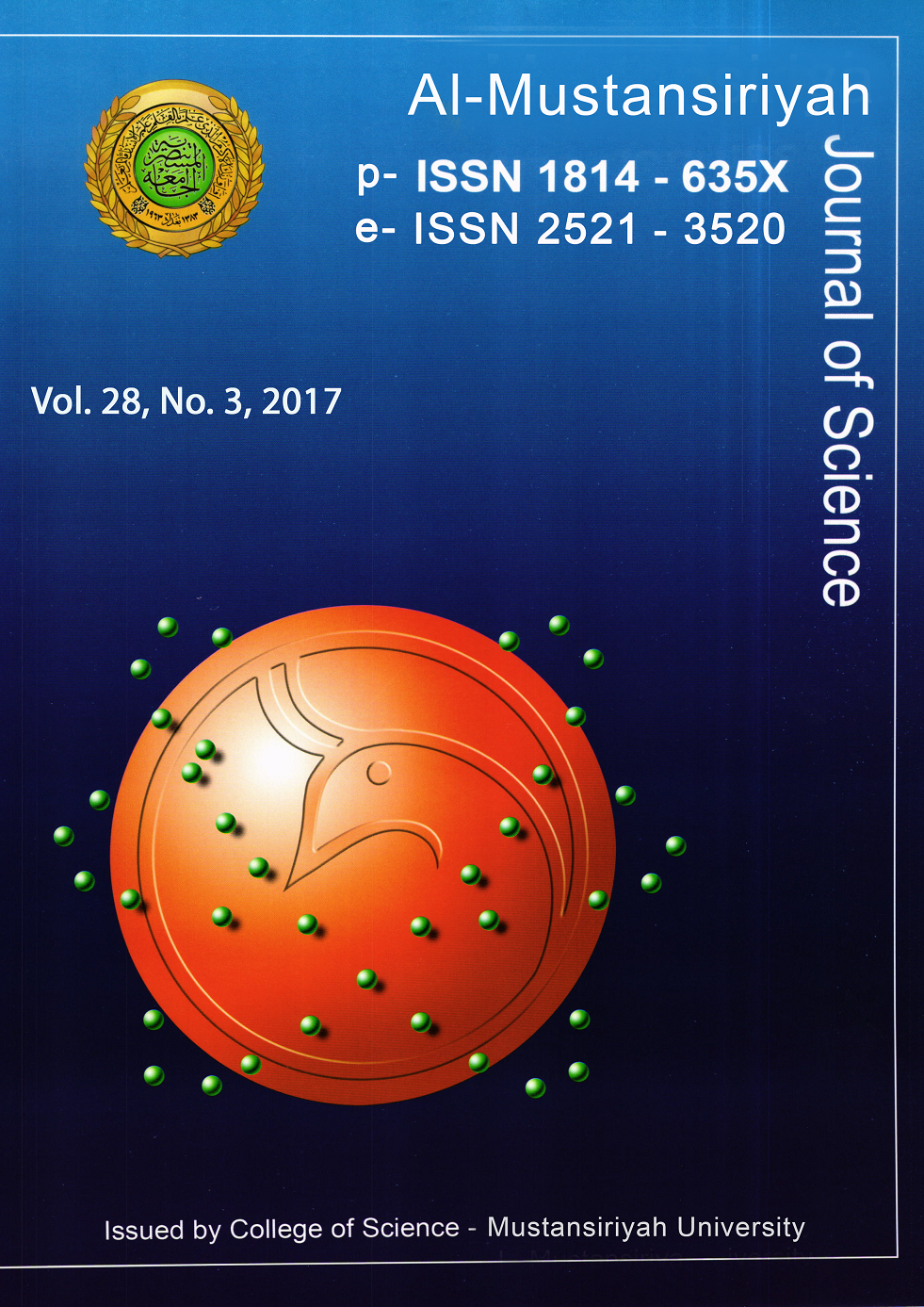The Inhibition Potential of Oregano (Origanum Vulgare) Extract Against Citrobacter freundii Invitro and Invivo
DOI:
https://doi.org/10.23851/mjs.v28i3.543Keywords:
C. freundii, Oregano, oxidative stress, MDA, GlutathioneAbstract
The study was designed to demonstrate the antimicrobial and antioxidant effects of Oregano against C. freundii. The study consist of two parts, the first part (invitro) including study the sensitivity of C. freundii against safflower extract and antibiotics. where, the results showed very high inhibition efficacy of extract, which reached to 30 mm, while Neomycin inhibition zone reach to 14mm, Novobiocin inhibition zone reach to 9mm and Tetracycline inhibition zone reach to 9mm In the second part (in vivo) used 24 albino rats and divide to six groups (each group consist 4 rats). control group, group injected with (1x105 CFU/ml/25mg) bacteria, group injected with (1x105 CFU/ml/25mg) bacteria and treated with neomycin, group injected with (1x105 CFU/ml/25mg) bacteria and treated with novobiocin, group injected with (1x105 CFU/ml/25mg) bacteria and treated with tetramycine, group injected with (1x105 CFU/ml/25mg) bacteria with extract. The MDA levels in infected group and treated groups with antibiotics increased and GSH levels in infected group and treated groups with antibiotics show decreased (P < 0.05) compared control rats. In treated group with extract, MDA and GSH levels show on-significant change compare with control rats. It was concluded from present study that the Oregano has an antimicrobial and antioxidant activity against C. freundii.Downloads
References
Indu, S. R.,. and Asfia Nayar, "Epidemiology, Prevalence and Identification of Citrobacter Species in Clinical Specimens in a Tertiary Care Hospital in India," J. Sci. Res. Pub. 4, ( 4),. 1-6, 2014.
AL-Thahab A. A., "Immunological effects of Citrobacter freundii cell free culture in rabbit," J. Pur. App. Sci, 23(2), 605-609, 2015.
Anjay .M.A, Vincent J, Girija B. Anoop P, "Fulminant Citrobacter meningitis With Multiple Periventricular Abscesses in ThreeMonth-Old Infant," J. Infec. Dis. , 7( 6), 429-432, 2003.
Karageorgopoulus, D.E., Kofteridis, D.P., Matthaiou, D.K., Sidiropoulou, V., Maraki, S. and Falagas, M.E. Samonis, G., "Citrobacter infections in a general hospital: characteristics and outcomes," J. Clin. Microbio. Infect. Dis.,. 28, (4) 61-68, 2009.
Reddy. K.R., "Microbiology and Parasitology.4th ed. Paras Medical Puplisher," New Delhis, 2010.
Abbott SL. Janda JM, "The genus Hafnia: from soup to nuts," J. Clin. Microbio. Rev. ,. 19, pp. 12-28, 2006.
Bastos MCF, Sá MHB Vermelho AB, "Bacteriologia Geral. 1 th ed Guanabara Koogan," Rio de Janeiro, 2007.
Defez. C., Bouziges. N, Mahamat. A., Sotto. A., and Lavigne. J.P. " molecular epidemiology of multidrug-resistant Citrobacter spp. Infections in a French university hospital. ," Eur. J. Clin. Microbio. Infect. Dis,. 26, pp. 439-441, 2007.
Mully, T.W., and Enlgish, J.C. Whalen, "Spontaneous Citrobacter freundii infection in an immunocompetent patient," Archives of dermatology.3 rd. , 143(1), 124-129, 2007.
Mehrdad I., Mohammad A. E. Mohammad R. A. and Roofchaee, A., "Effect of dietary oregano (Origanum vulgare L.) essential oil on growth performance, cecal microflora and serum antioxidant activity of bbroiler chickens," J. Biotechn. , 10, ( 32). 6177-6183, 2011.
Skandamis. P.N., Coote. P.J., Nychas. G.J.E.and Lambert. R.J.W, "A study of the minimum inhibitory concentration and mode of action of oregano essential oil, thymol and carvacrol," J. Appl. Microbiol, 91, pp. 453-462, 2001.
Pardali E, Feggou E, Kokkini S, Scouras ZG Karpouhtsis I, "MavraganiTsipidou P. Insecticidal and genotoxic activities of oregano essential oils," J. Agric. Food. Chem, 46, pp. 1111-1115, 1998.
Florou-Paneri. P, Christaki. E, Fletouris. D.J., Spais. A.B.and Botsoglou. N.A, "Effect of dietary oregano essential oil on performance of chickens and on iron-induced lipid oxidation of breast, thigh and abdominal fat tissues," J. Br. Poult. Sci., 43, pp. 223-230, 2002.
Ahmed. I.. Owais. F.,and Aail. M., "Modernphytomedicine. ," Wiley VHC, Weinheim, Germany, 2006.
J.F. MacFaddin, Biochemical tests for identification of medical bacteria. Philadelphia, USA: Lippincott Williams and Wilkins, 2000.
Clinical and Laboratory Standards Institute, "Performance Standards for Antimicrobial Susceptibility Testing; Twenty-Fourth Informational Supplement. CLSI document M100-S24. ," Wayne, Pennsylvania, 34, ( 1). 1-226, 2014.
Iwahi T., "In vitro and in vivo activities of SCE-2787, a new parenteral cephalosporin with a broad antibacterial spectrum. ," J. Antimicrob. Agent. Chemo., 36, ( 7). 1358-1366, 1992.
Mahmood N. A.,"Glutathion-S- transferase Enzyme and Malondialdehyde (MDA) in Colorectal Cancer and in Healthy Control," J. Can. Med. Gen, 3, (1). 21-26, 2014.
Dorman. H.J.D., and Deans S.G., "Antimicrobial agents from plants: antibacterial activity of plant volatile oils. ," J. App. Microbio, 88, pp. 308-316, 2000.
Ahmed .N., Sabahat. C., Perween. S. and Masood. T., "Antibacterial effects of oregano (origanum vulgare) against gram negative bacilli. ," Pak. J. Bot, 39(2). 609-613, 2007.
Loarca-Pina, C.C. G., Lecona-Uribe. S. and Gonzalez Arcila-Lozano. E.M., "Oregano: properties, composition and biological activity," Arch. Latinoam. Nutr, 54( 1). 100-111, 2004.
Tian.H., and Lai. D.M., "Analysis on the volatile oil in Origanum vulgare," J. Zhong Yao Cai, 29, ( 90. 920-921, 2006.
Chorianopoulos. C., N,, Nychas .G.J., and Komaitis Proestos. M., "RP-HPLC analysis of the phenolic compounds of plant extracts investigation of their antioxidant capacity and antimicrobial activity. ," J. Agric. Food Chem, 53, pp. 1190-1195, 2006.
Darogha. S. N., "Antibacterial activity of Quercus infectoria extracts against bacterial isolated from wound infection," J. Kirk. Uni. Sci. Stu. , 4, ( 1). 20-30, 2009.
EL-Nomeary. Y.A.A., EL-Kady, Azza. R.I., Badr. M..M., Sawsan. F.A.F., Ahmed. M., EL-Allawy. H.M.H., and Ibrahim. A.M. "Improving the Utilization of Rabbit Diets Containing Vegetable Oil by Using Fennel (Foeniculum vulgare) And Oregano (Origanum vulgare L) as Feed Additives," J. Life Sci. , 10, ( 1). 2625-2636, 2013.
Downloads
Key Dates
Published
Issue
Section
License
(Starting May 5, 2024) Authors retain copyright and grant the journal right of first publication with the work simultaneously licensed under a Creative Commons Attribution (CC-BY) 4.0 License that allows others to share the work with an acknowledgement of the work’s authorship and initial publication in this journal.






















